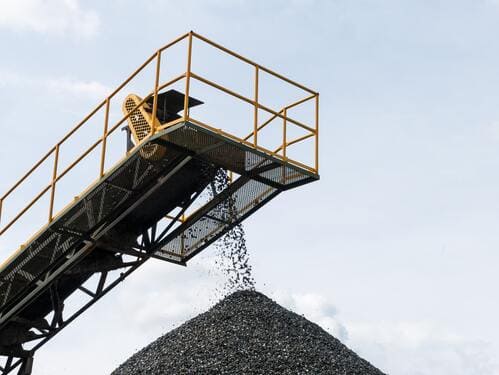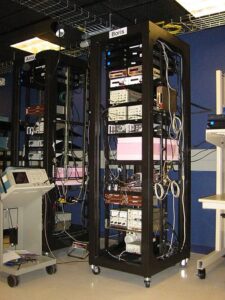Distributed temperature sensing systems as well as fiber Bragg optic sensors are focused on the continuous monitoring of the constructions’ health condition and prevention of potential damages. The DTS system consists of a fiber optic cable, typically several kilometers long, that works as a temperature sensor. As a result, specialists can watch all dynamic temperature changes in a continuous temperature profile.
DTS Systems as a Fire Detection Technology
In the mining industry, the risk of fires still remains very high. Conventional fire and heat alarm systems require constant and expensive maintenance and are not as effective as fiber optic monitoring systems. Thanks to modern DTS technology, both of these problems are now solved.
There are many forces in mines that can cause a fire. The possibility of fire is especially high in certain locations due to the complicating factors such as:
- geological settings;
- presence of the vehicles, heat-generating and mobile equipment;
- conveyor failures;
- lighting faults, etc.
Distributed temperature sensing systems have been proven to outperform standard fire detection systems in a range of aspects including efficiency and high level of safety.
The DTS system includes a single fiber optic cable and a DTS unit. The traditional system includes many components and devices. The distinction of DTS results in lower installation and maintenance costs due to less equipment, and in improved system reliability. Therefore, there is no need in its regular service that can be complicated because of the difficulty of access and huge size of the mine. Moreover, the conducted field projects have demonstrated that fiber optic sensors inform the operators about the heat significantly earlier than a fire starts.
All these advantages have made DTS technology one of the main methods for the detection of potential fires or other abnormal conditions.
Fiber Optic Sensors for Detection of Faulty Conveyor Belt Rollers
The conveyor belts are cost-effective instruments for continuous transporting of dry bulk materials over various distances. Due to the latest technologies, the accidents related to the problems with conveyor belts are relatively rare in modern underground coal mines. However, to this day there is a possibility of causing damage related to the conveyor belt accidents that can result in the interruption of the production process.
The reliability of the whole conveyor belt depends on the robustness of its separate components. Distributed temperature sensing (DTS) system helps to monitor the thermal conditions of each idler and detect the malfunctions. DTS systems use the latest advancements of fiber optic technology. They have proven to be a safe method of application in underground mines.
There are some aspects to consider when choosing the suitable monitoring system. Firstly, it is not easy to obtain data from a vast area. It requires the setting up of thousands of sensor elements. Secondly, the data transmission can be challenging due to the underground mine environment. Therefore, some types of equipment are prohibited for usage, such as electrical cables. Fiber optic monitoring systems have been able to solve a number of such issues that engineers usually face during underground mining.
The DTS system consists of a DTS unit and a fiber optic cable. The system measures temperature along the entire length of the cable and transmits the data to the operators who can detect any mechanical failures of the rolling components at an early stage. The specialists see real-time data of the conveyor structure and the surrounding area.
The specialists conducted a range of experiments to find the most effective placement of the fiber optic monitoring system. The problem is that fiber optic sensors can’t be located over the idlers because they will interrupt the operation. So they are attached to the frame of the idler, as close to the bearing as possible. This affects the results because fiber optic sensors take longer to capture the heat. However, they still have better results compared to the traditional methods.
Fiber Optic Sensing for Monitoring of Roof Activity
According to statistics, there are many causes that can lead to mine accidents including dust explosions, mine support deterioration, etc. However, the most common cause of the accidents that take place in underground coal mines is mine collapse.
Design and functioning of the underground mines creates a number of complicated factors for operation. The dynamism of mining operations and increasing depth can lead to the associated risks and jeopardize an acceptable level of safety. At the same time, there are always natural risks to the mine structures, such as seismic shocks which can also lead to roof stratum displacements.
Roof activity monitoring can be used for a variety of purposes, including structural health construction monitoring of the underground openings and design optimization. For the majority of projects, fiber optic monitoring systems are applied due to their ease of use in harsh environments compared to other conventional methods.
Fiber optic sensing monitoring is able to help in reduction of the mine roof displacement and thus avoid severe consequences. There are different types of fiber Bragg grating sensors that are used to monitor displacement, temperature or strain in underground openings or nearby them depending on the purposes. FBG sensors have proved to be reliable and accurate monitoring equipment of roof activities in underground coal mining. Modern fiber optic monitoring systems have made it possible to display all changes of the required parameters on the screen almost instantly and prevent any accidents in underground mines.
The conducted projects on the mining sites have demonstrated the benefits of fiber optic sensors. The fiber optic monitoring systems can detect the slight roof displacement during the progressive face advance. The received data is usually used for roadway support and design of the mine.
In conclusion, thanks to the latest state-of-the-art technologies nowadays there is an opportunity to monitor structural health constantly. That is why distributed temperature sensing systems are widely applied for structural health monitoring of different constructions including mines. The fiber optic sensing has found many spheres of applications due to the qualities it has.
Optromix is a DTS system manufacturer that provides top of the line distributed temperature sensing systems suitable for monitoring commerce networks. If you have any questions or would like to buy a DTS system, please contact us at info@optromix.com




 A team of scientists from Israel and Russia has developed a novel, straightforward, and low-cost
A team of scientists from Israel and Russia has developed a novel, straightforward, and low-cost  Quantum-enhanced metrology is regarded as a popular area of research for years because of its promising applications, varying from atomic clocks to biological imaging. According to the researches, a non-standard
Quantum-enhanced metrology is regarded as a popular area of research for years because of its promising applications, varying from atomic clocks to biological imaging. According to the researches, a non-standard  Companies from the U.S. and Japan have developed for the first time a new
Companies from the U.S. and Japan have developed for the first time a new